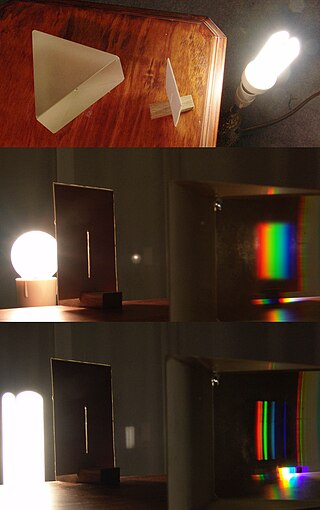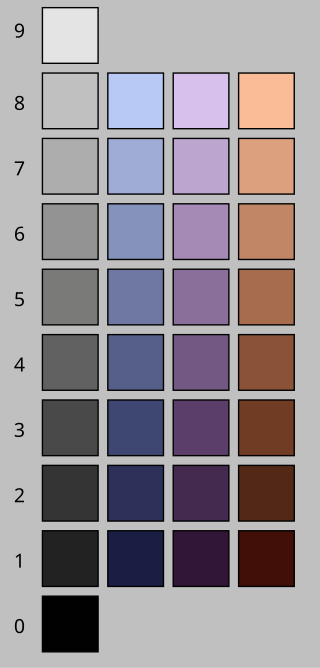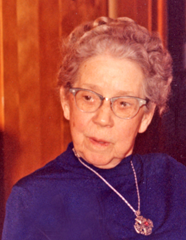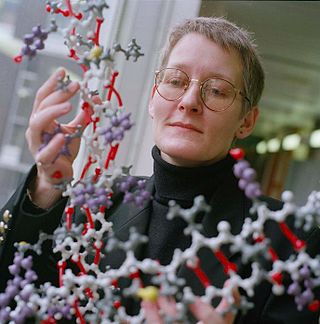Related Research Articles

A set of primary colors or primary colours consists of colorants or colored lights that can be mixed in varying amounts to produce a gamut of colors. This is the essential method used to create the perception of a broad range of colors in, e.g., electronic displays, color printing, and paintings. Perceptions associated with a given combination of primary colors can be predicted by an appropriate mixing model that reflects the physics of how light interacts with physical media, and ultimately the retina.

The Natural Color System (NCS) is a proprietary perceptual color model. It is based on the color opponency hypothesis of color vision, first proposed by German physiologist Ewald Hering. The current version of the NCS was developed by the Swedish Colour Centre Foundation, from 1964 onwards. The research team consisted of Anders Hård, Lars Sivik and Gunnar Tonnquist, who in 1997 received the AIC Judd award for their work. The system is based entirely on the phenomenology of human perception and not on color mixing. It is illustrated by a color atlas, marketed by NCS Colour AB in Stockholm.

The International Commission on Illumination is the international authority on light, illumination, colour, and colour spaces. It was established in 1913 as a successor to the Commission Internationale de Photométrie, which was founded in 1900, and is today based in Vienna, Austria.

Color constancy is an example of subjective constancy and a feature of the human color perception system which ensures that the perceived color of objects remains relatively constant under varying illumination conditions. A green apple for instance looks green to us at midday, when the main illumination is white sunlight, and also at sunset, when the main illumination is red. This helps us identify objects.
Optica is a professional society of individuals and companies with an interest in optics and photonics. It publishes journals and organizes conferences and exhibitions. It currently has about 488,000 customers in 183 countries, including nearly 300 companies.
Color science is the scientific study of color including lighting and optics; measurement of light and color; the physiology, psychophysics, and modeling of color vision; and color reproduction.
Chromatic adaptation is the human visual system’s ability to adjust to changes in illumination in order to preserve the appearance of object colors. It is responsible for the stable appearance of object colors despite the wide variation of light which might be reflected from an object and observed by our eyes. A chromatic adaptation transform (CAT) function emulates this important aspect of color perception in color appearance models.

A color rendering index (CRI) is a quantitative measure of the ability of a light source to reveal the colors of various objects faithfully in comparison with a natural or standard light source. Light sources with a high CRI are desirable in color-critical applications such as neonatal care and art restoration. It is defined by the International Commission on Illumination (CIE) as follows:
Color rendering: Effect of an illuminant on the color appearance of objects by conscious or subconscious comparison with their color appearance under a reference or standard illuminant.
In photography, painting, and other visual arts, middle gray or middle grey is a tone that is perceptually about halfway between black and white on a lightness scale; in photography and printing, it is typically defined as 18% reflectance in visible light.

A standard illuminant is a theoretical source of visible light with a spectral power distribution that is published. Standard illuminants provide a basis for comparing images or colors recorded under different lighting.
Henry Hemmendinger was an American color scientist.

Lightness is a visual perception of the luminance of an object. It is often judged relative to a similarly lit object. In colorimetry and color appearance models, lightness is a prediction of how an illuminated color will appear to a standard observer. While luminance is a linear measurement of light, lightness is a linear prediction of the human perception of that light.

The International Colour Association is a learned society whose aims are to encourage research in all aspects of colour, to disseminate the knowledge gained from this research, and to promote its application to the solution of problems in the fields of science, art, design and industry on an international basis. The AIC also aims for a close cooperation with existing international organizations, such as, for example, the International Commission on Illumination (CIE), the International Organization for Standardization (ISO), and the International Commission for Optics (ICO), regarding issues concerned with colour. The AIC will neither duplicate the work of these bodies nor will it attempt to assume any of their responsibilities. In 2009 the AIC agreed on the creation of an International Colour Day, which is celebrated in many countries around the world.

Deane Brewster Judd was an American physicist who made important contributions to the fields of colorimetry, color discrimination, color order, and color vision.
The Genetics Society of America (GSA) is a scholarly membership society of more than 5,500 genetics researchers and educators, established in 1931. The Society was formed from the reorganization of the Joint Genetics Sections of the American Society of Zoologists and the Botanical Society of America.

The ISCC–NBS System of Color Designation is a system for naming colors based on a set of 13 basic color terms and a small set of adjective modifiers. It was first established in the 1930s by a joint effort of the Inter-Society Color Council (ISCC), made up of delegates from various American trade organizations, and the National Bureau of Standards (NBS), a US government agency. As suggested in 1932 by the first chairman of the ISCC, the system’s goal is to be "a means of designating colors in the United States Pharmacopoeia, in the National Formulary, and in general literature ... such designation to be sufficiently standardized as to be acceptable and usable by science, sufficiently broad to be appreciated and used by science, art, and industry, and sufficiently commonplace to be understood, at least in a general way, by the whole public." The system aims to provide a basis on which color definitions in fields from fashion and printing to botany and geology can be systematized and regularized, so that each industry need not invent its own incompatible color system.

Dorothy Nickerson was an American color scientist and technologist who made important contributions in the fields of color quality control, technical use of colorimetry, the relationship between color stimuli and color perceptions, standardization of light sources, color tolerance specification, and others.

Lincoln David Stein is a scientist and Professor in bioinformatics and computational biology at the Ontario Institute for Cancer Research.

Teresa K. Attwood is a Professor of Bioinformatics in the Department of Computer Science and School of Biological Sciences at the University of Manchester and a visiting fellow at the European Bioinformatics Institute (EMBL-EBI). She held a Royal Society University Research Fellowship at University College London (UCL) from 1993 to 1999 and at the University of Manchester from 1999 to 2002.
Richard Sewall Hunter (1909–1991) was a pioneering American color scientist and founder of Hunter Associates Laboratory (HunterLab). He is best known as the inventor in 1942 of the Hunter L,a,b color measurement system the precursor to the CIELAB color space.
References
- ↑ Gage, H. P (1940). "Color Theories and the Inter-Society Color Council". Journal of the Society of Motion Picture Engineers. 35 (10): 361–87. doi:10.5594/J10038.
- ↑ "1950 Annual Meeting of the Inter-Society Color Council". Journal of the Optical Society of America. 40 (2): 92. 1950. doi:10.1364/JOSA.40.000092.
- ↑ Series Description and Inventory, Accession 2188,, Hagley Museum and Library, Wilmington, DE USA
- ↑ Brewster Judd, Deane (1979). Contributions to Color Science. University of Michigan Library, Center for Building Technology. pp. 219–224. Retrieved 10 September 2014.
- ↑ Nickerson, Dorothy (Spring 1982). "Fifty years of the inter-society color council. I. Formation and early years". Color Research & Application. 7 (1): 1–11. doi:10.1002/col.5080070102.
- ↑ W. J. Keirnan, The Story of the Inter-Society Color Council, Archived 2015-05-24 at the Wayback Machine ,"Inter-Society Color Council Newsletter", Number 173, September–December 1964
- ↑ "A.O.C.S. Becomes member of Inter-Society Color Council". Journal of the American Oil Chemists' Society. 25: 16. 1948. doi:10.1007/BF02553640. S2CID 189784854.
- ↑ Gooch, Jan W. (2011). "Inter-Society Color Council". In Gooch, Jan W. (ed.). Encyclopedic Dictionary of Polymers. New York: Springer. pp. 394–395. doi:10.1007/978-1-4419-6247-8_6424. ISBN 978-1-4419-6246-1.
- ↑ Nickerson, D (1940). "Standardization of color names the ISCC-NBS Method". Am Dyestuff Reptr. 29: 392.
- ↑ Judd, D. B.; MacAdam, D. L. (September 1939). "Method of Designating Colors". Journal of Research of the National Bureau of Standards. 23 (3): 355–385. doi: 10.6028/jres.023.019 .
- ↑ "Aims and Purposes". ISCC. Retrieved 10 September 2014.
- ↑ "Color Research & Application". Color Research & Application. doi: 10.1002/(ISSN)1520-6378 . Retrieved 10 September 2014.
- ↑ "Colour Literacy Project". Colour Literacy Project. Retrieved 2022-12-06.